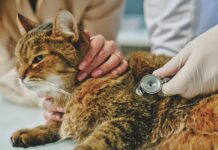When your cat starts missing meals or her free-choice bowl isn’t requiring as many refills, you need to take action. Not eating can be fatal for your feline friend, as it can predispose her to the most common liver disease in cats, hepatic lipidosis (HL).
HL occurs when fats are metabolized rapidly to supply energy for a cat that is not eating. This rapid mobilization can result in an accumulation of fat within liver cells, compromising liver function. HL is more likely to occur in overweight cats that stop eating.
Ideally, HL (also known as fatty liver disease) should be prevented by assuring that your cat is eating appropriately. If it develops, however, it must be caught early and treated aggressively. Affected cats usually begin with anorexia that may worsen with vomiting. In-hospital stabilization, including rehydration, normalization of electrolytes, and institution of a plan to promote adequate nutrition, can take up to 10 days. Complete recovery, if achieved, can take as long as 12 weeks.
“Due to hepatic lipidosis, I get nervous when a cat is completely off feed for over three to four days. I often encourage treats and, depending on the disease, feeding small amounts of cooked meats to see if we can stimulate appetite,” says Joseph J. Wakshlag, DVM, PhD, chief of the nutrition service at Cornell University Hospital for Animals.
Reasons for Anorexia
Anorexia is a sustained loss of appetite, and it most commonly occurs as a result of illness in cats. Gastrointestinal (GI) diseases like inflammatory bowel disease, GI lymphoma, or a foreign body in the GI tract can cause cats to stop eating, as can fevers and chronic liver or kidney disease. Dental disease may be so painful that your cat chooses not to eat, and any disease that interferes with a cat’s sense of smell (i.e., upper respiratory infections) can also decrease her appetite.
Because so many diseases can cause your cat to stop eating, a thorough veterinary evaluation is needed, starting with a detailed history and physical exam. Often bloodwork and other diagnostic tests are necessary to make an accurate diagnosis.
How to stimulate your cat’s appetite depends somewhat upon the cause of anorexia. Most veterinarians will recommend treating the underlying disease, prescribing appetite stimulants (more on that below), and trying different foods. Particularly difficult cases may be referred to a veterinary nutritionist, says John Loftus, PhD, DVM, co-section chief of small animal internal medicine at the Cornell University Hospital for Animals.
Stress, whether something major like a move or adding a new pet or as seemingly minor as rearranging the furniture, can cause your cat to back off of her food. Obviously, you can’t avoid all stress in your cat’s life, but minimizing it by providing safe, quiet places for your cat to retire to, adequate numbers of litterboxes, time and environment for exercise, play, and one-on-one socialization, and perhaps using synthetic feline calming pheromones such as Feliway can be very helpful.
Finicky
Some cats simply seem to be finicky. “I am a fan of allowing rotation of foods,” says Dr. Wakshlag, although your ability to do this may depend on the disease process your cat is experiencing. “Many cat owners have some success rotating around different canned products from seafood to poultry to terrestrial mammal bases to keep a cat interested. It’s important to get the calories into cats to prevent hepatic lipidosis and muscle wasting,” says Dr. Wakshlag.
Different flavors may motivate your sick cat. Note: If you start your kitten or new cat off by rotating foods, it may help you in the future if she loses her appetite.
Remember that your cat’s desire to eat is motivated by scent. Start by warming your cat’s normal food in the microwave, but don’t serve it hot. Always check to make sure that it is not too hot in one area after heating, and stir it up. You can also simply add warm water and make a slurry.
Additional tricks to entice your sick cat’s appetite include:
- Pouring juice from a can of tuna packed in water over her food.
- Adding plain shredded pieces of freshly cooked beef or chicken to her food.
- For cats who can tolerate dairy products, plain or vanilla yogurt or ricotta cheese stirred in with the normal food may hit the spot.
- Switching to a different flavor of your cat’s standby favorite.
- Switching to wet foods with gravy/sauce if feeding loaf-type foods.
Veterinary Intervention
Talk with your veterinarian about appetite stimulants such as mirtazapine. Originally prescribed as an anti-nausea medication for cats, it can stimulate the appetite as well. This drug can be given orally or in transdermal formulation. The latter may be helpful in cats that are hesitant to eat, as you can simply rub the medication on the inside of your cat’s ear.
If your cat adamantly refuses to eat in spite of these measures, she may need a feeding tube placed for a short time. “In some cases, inappetence or anorexia in cats will require short- or long-term management with a feeding device, such as an esophagostomy tube, that will allow pet owners to assist in feeding their cats that refuse to eat voluntarily. This is well-tolerated in most cats that require this level of intervention,” says Dr. Loftus.
With training, most owners can feed their cat at home, carefully mixing a quality, balanced slurry to administer via the tube. The goal is to get your cat’s nutritional status back on track and, hopefully, her appetite will then take over and she will eat happily on her own




